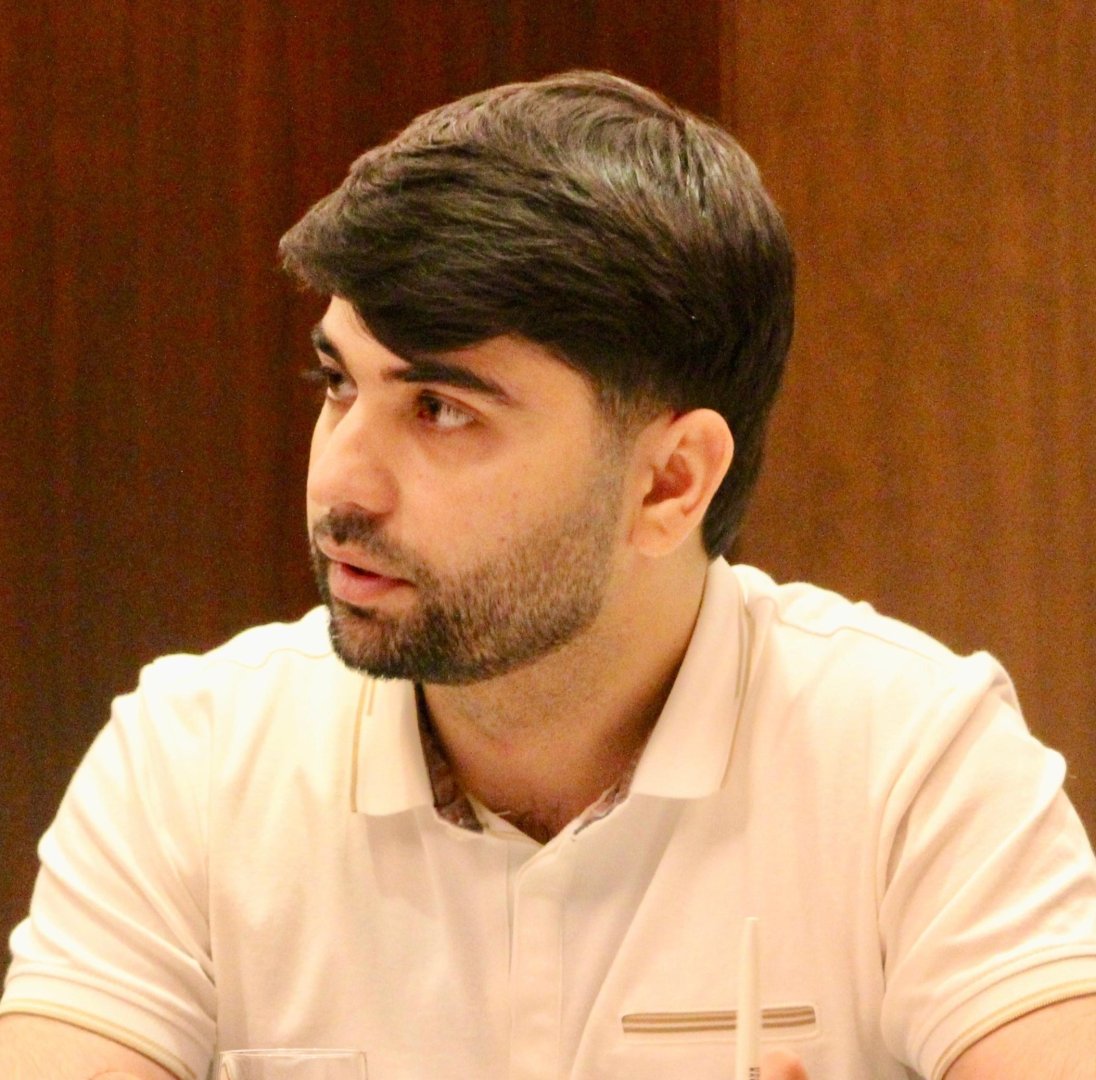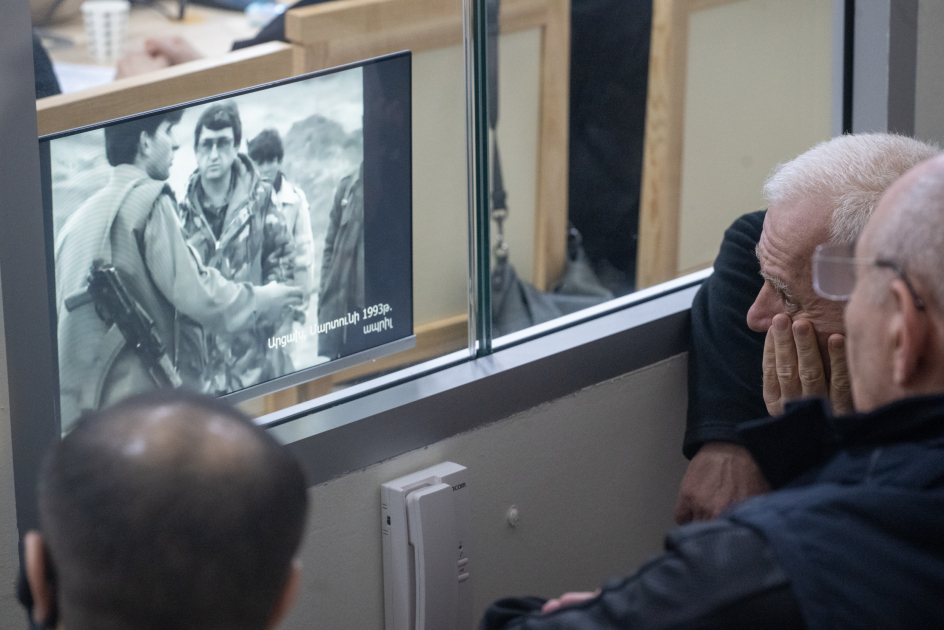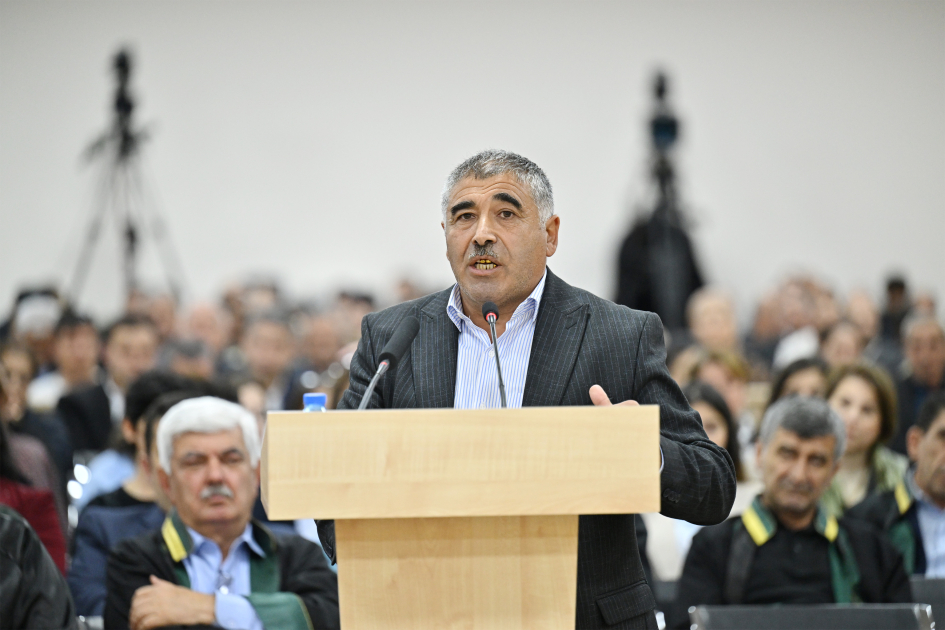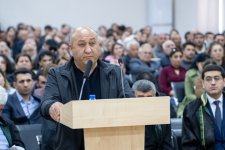BAKU, Azerbaijan, May 5. Public hearings on the criminal case against citizens of the Republic of Armenia Arayik Harutyunyan, Arkadi Ghukasyan, Bako Sahakyan, Davit Ishkhanyan, Davit Babayan, Levon Mnatsakanyan and others, who are accused of committing crimes against peace and humanity, war crimes, including the preparation and conduct of a war of aggression, acts of genocide, violation of the laws and customs of warfare, as well as terrorism, financing of terrorism, forcible seizure of power, forcible retention of power and numerous other crimes as a result of Armenia's military aggression, continued on May 5, Trend reports.
The hearings held at the Baku Military Court were presided over by Judge Zeynal Aghayev and a panel consisting of Jamal Ramazanov and Anar Rzayev (reserve judge Gunel Samadova). Each of the accused was provided with an interpreter into the language of their choice, as well as defense attorneys.
Present at the hearings were the accused and their defense attorneys, some of the victims, their legal successors and representatives, as well as prosecutors in charge of public prosecution.
Judge Zeynal Aghayev introduced the panel of judges, interpreters, etc. to those of the victims who were participating in the hearings for the first time, and also explained their rights and obligations stipulated by national legislation.
The court first examined another video footage related to the occupation of the Khojavand district by the Armenian armed forces. The footage, filmed by Armenian forces in April 1993, depicts a group of armed servicemen in the Khojavand district, which was then under Armenian military occupation. Among those featured in the video are Serzh Sargsyan, who later served as President of Armenia from 2008 to 2018, and David Ishkhanyan, currently standing trial.
During court proceedings, the Armenian-language video was translated, revealing that Sargsyan had visited the area to inspect military units.
In the footage, Monte Melkonyan is seen reporting directly to Sargsyan, who states: “We are not talking about stopping the fire right now. We are talking about offensive operations and capturing more territory.”
Sargsyan is also shown touring the area and engaging in discussions with D.Ishkhanyan, Commander of the 28th Khojavand battalion, who provides updates on military operations in the Aghdam district, specifically the Abdal-Gulabli direction. Their conversations touch on operational conditions, troop logistics, and supply lines.
The video concludes with Sargsyan briefly addressing soldiers on the ground.
Following the screening, prosecutors questioned David Ishkhanyan about the video. He confirmed his recollection of the footage and explained the context of Sargsyan’s visit: “They came to my battalion. They were familiarizing themselves with the situation at the battalion’s positions.”
D.Ishkhanyan identified several individuals in the video, including Serzh Sargsyan, Monte Melkonyan, and Movses Hakobyan—Melkonyan’s deputy at the time and later Chief of the General Staff of the Armenian Armed Forces. He also mentioned Aramayiz Karapetyan, his former Chief of Staff. “The person standing behind in the video footage is the driver. "I don’t remember exactly, but he was either the driver for Movses Hakobyan or Monte Melkonyan,” Ishkhanyan mentioned.
In response to questions, Ishkhanyan commented on Sargsyan’s statement about “occupying even more territories,” saying: “I cannot comment on what Sargsyan mentioned.”
The defendant stated that the battalion commanded by Ishkhanyan received support from the headquarters of the "Khojavand Defense District."
He also emphasized that the battalion took part in combat operations in the Aghdam district during July–August 1993.
The court then presented a video footage related to the occupation of Azerbaijan’s Lachin district by Armenian armed forces.
The footage, filmed by Armenian militants on May 18, 1992, shows burning houses and armed fighters. In one scene, a militant points to a burning house and says, “Ashot, Ashot, watch it burn.”
The hearing continued with testimonies from victims.
Jamal Mammadov, a resident of the Jijimli village in Lachin district, testified that the village was occupied by Armenian forces in May 1992. He also recalled that his father, Mehdi Mammadov, was killed by Armenian soldiers on August 12, 1989. “According to Russian soldiers, my father was killed by an Armenian named Kamo. I was 18 years old at the time,” he stated.
Another victim, Aghali Ibrahimov, born in 1961 in the Jaghazur village of Lachin district, confirmed the occupation date as May 18, 1992. He described how, prior to the occupation, the village—located on the border with Armenia—was repeatedly shelled from Armenia’s Gorus district and Digh village. "Until May 8, 1992, the attacks appeared fragmented. But from May 8 onward, they were clearly carried out under a single command. They used 'Grad' and 'Alazan' missiles and long-range artillery,” he said.
Ibrahimov added that his family lost significant property in the village, including a two-story house with six rooms, auxiliary structures, fruit trees, livestock, poultry, and household items, resulting in extensive material damage.
Then, protocols related to the massacre committed in the village of Balligaya of the Goranboy district on August 28, 1992, were read out and horrific photos from the scene were screened.
According to the documents, residents of the Naghdali village in Lachin district, who were temporarily resettled in the shacks nearby the Gulustan forest in the Balligaya village of the Goranboy district following the occupation of the Lachin district, were shot at by firearms by the Armenian armed forces on August 28, 1992 at approximately 05:00, as a result of which 24 people were killed and 9 were wounded.
Of those killed during the massacre, 7 were under-18, 4 were persons over 60 years, in total, 13 were women and 11 men.
The court next reviewed documents regarding the shelling of Azerbaijani civilians in the village of Gulustan, Goranboy district, on September 19, 1992. According to the documents, at around 6 p.m. on the same day, Armenian armed forces attacked residents who were harvesting potatoes. As a result, 20 civilians were killed, and several others were injured.
On the same day, during the attack on Gulustan village, officers from the Aghjakand police station in the district attempted to resist the assault and were ambushed while evacuating civilians. 13 people were killed, and 8 others were injured; 2 police officers killed and 2 more wounded.
Victim Binnet Mehdiyev testified that he had resettled in the village of Naghdali in the Lachin district as an internally displaced person (IDP) from the city of Shusha. He stated that the village was occupied on May 17–18, 1992, after which they moved to Balligaya village in the Goranboy district.
B.Mehdiyev said that on August 28, 1992, Armenian armed forces attacked again, resulting in the deaths of 24 people, including his father, mother, two brothers, sister, and other close relatives.
“During the attack, they killed the wife and six children of my relative Vazir. One of the children was just a six-month-old baby,” he added.
Another victim, Shahla Guliyeva, stated that in May 1992, her family fled from Lachin district as IDPs. They first moved to Bash Qishlag village in Goranboy, and later to Balligaya village in the same district.
Noting that on August 27, 1992, she saw a helicopter in the area and informed her mother-in-law about it, Shahla Guliyeva stated: “That night we slept in fear. On August 28, at around 5 a.m., I saw that everything was engulfed in flames.”
Sh.Guliyeva survived by chance since she ran away from the shack to the nearby forest. She was shot during the incident.
She stated that her mother-in-law, sisters-in-law, her mother-in-law’s 110-year-old mother-in-law and other relatives were killed during the incident.
Victim Nasraddin Mustafayev underscored that on September 19, 1992, they were fired upon by Armenian army units in the village of Gulustan, Goranboy district, where they were harvesting potatoes, and as a result, he was wounded in the leg. “I lost a third of my toes,” he said.
Victim Sahiba Mustafayeva mentioned that on September 19, 1992, while they were in the village of Gulustan in Goranboy harvesting potatoes with her father Kazim and grandfather Salman, and on the way back, the car driven by her father was fired upon by Armenian soldiers. One of the bullets hit her father and the other her grandfather. Salman. S. Mustafayeva, who was 12 years old at the time, was shot in the leg and lost consciousness. She later learned that many people, including her grandfather Salman and her father Kazim, were killed during that incident.
Victim Nofel Nuruyev underlined that on September 19, 1992, on the instructions of her supervisor Qafqaz Rustamov, she drove a “Zil” vehicle to the village of Gulustan in Goranboy to harvest potatoes with Israfil Ismayilov, a resident of Tapgaragoyunlu village, and 3 Azerbaijanis, whom he didn’t know and picked up in her car on the way. She also saw there were many other residents who arrived for harvesting potatoes. On his way back, after passing a police post, Armenian soldiers suddenly opened fire on his car in the forest area. At that time, the police arrived to help and the shooting with the Armenian soldiers continued. As a result, he received a bullet wound in the eye, and Israfil Ismayilov was killed. He is currently blind in one eye. She later learned that about 20 Azerbaijanis were killed and several others were wounded in that incident. Among the deceased, he recognized Kazim Mammadov, a resident of the Garagashly village, and his father-in-law Salman Gojayev.
In his statement, Victim Khaleddin Rustamov pointed out that he served as a policeman in the Ashagi Agjakand Police Department of the Goranboy district, adding that on September 19, 1992, he was on duty at the police post in the village of Gulustan. Rustamov said that on that day, many Azerbaijani residents, who were returning from the potato harvesting in the village of Gulustan in the evening, were fired upon. As a result, he and police officer Jeyhun Teyyubov were wounded, while Elkhan Suleymanov and Yavar Kazimov were killed.
The conclusions of forensic medical examination conducted on the victims were also announced during the hearings.
The next court hearing is scheduled for May 8.
We recall that a total of 15 Armenian nationals are being charged with numerous crimes involving direct leadership and participation of the Armenian state, its state bodies, military forces and illegal armed formations, verbal and written instructions, orders and assignments, provision of material and technical support, central governance, as well as the exercise of rigorous control, with the aim of committing military aggression and acts of terror against the Republic of Azerbaijan in the territory of Azerbaijan in violation of domestic and international law, and involving Robert Sedraki Kocharyan, Serzh Azati Sargsyan, Vazgen Mikaeli Manukyan, Vazgen Zaveni Sargsyan, Samvel Andraniki Babayan, Vitali Mikaeli Balasanyan, Zori Hayki Balayan, Seyran Mushegi Ohanyan, Arshavir Surenovich Garamyan, Monte Charles Melkonyan and others, including criminal acts committed during the course of the war of aggression waged by the aforementioned criminal group.
The said persons, i.e. Arayik Vladimiri Harutyunyan, Arkadi Arshaviri Ghukasyan, Bako Sahaki Sahakyan, Davit Rubeni Ishkhanyan, David Azatini Manukyan, Davit Klimi Babayan, Levon Henrikovich Mnatsakanyan, Vasili Ivani Beglaryan, Erik Roberti Ghazaryan, Davit Nelsoni Allahverdiyan, Gurgen Homeri Stepanyan, Levon Romiki Balayan, Madat Arakelovich Babayan, Garik Grigori Martirosyan, Melikset Vladimiri Pashayan, are being charged under Articles 100 (planning, preparing, initiating and waging a war of aggression), 102 (attacking persons or organizations enjoying international protection), 103 (genocide), 105 (extermination of the population), 106 (enslaving), 107 (deportation or forced displacement of the population), 109 (persecution), 110 (enforced disappearance of people), 112 (deprivation of liberty contrary to international law), 113 (torture), 114 (mercenary service), 115 (violation of the laws and customs of warfare), 116 (violation of international humanitarian law during armed conflict), 118 (military robbery), 120 (intentional murder), 192 (illegal entrepreneurship), 214 (terrorism), 214-1 (financing terrorism), 218 (creation of a criminal association (organization)), 228 (illegal acquisition, transfer, sale, storage, transportation and possession of weapons, their components, ammunition, explosives and devices), 270-1 (acts threatening aviation security), 277 (assassination of a state official or public figure), 278 (forcible seizure and retention of power, forcible change of the constitutional structure of the state), 279 (creation of armed formations and groups not provided for by law) and other articles of the Criminal Code of the Republic of Azerbaijan.









































































